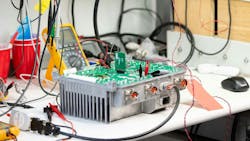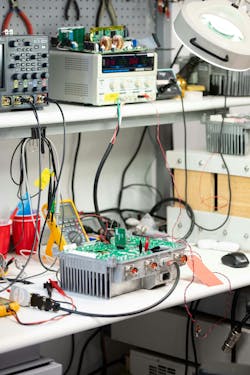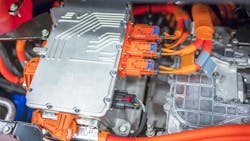Designing for Safety: Why Early System Integration Testing is Critical to Electrification Success
Key Highlights
- Conducting testing early in the design process ensures on-board chargers meet electric vehicle performance and safety requirements.
- Testing should be centered on optimizing electrical interoperability, thermal management, environmental resilience and software integration.
- System-level integration testing assures on-board chargers work as desired with other electric vehicle components in a range of applications.
As electrification accelerates across various industries, from material handling and lawn care to airport ground support and powersports, the on-board charger has become a central component in the electric powertrain. Yet, its complexity and interdependence with other systems demand more than just robust design.
Early system-level integration testing is essential to uncover and resolve issues before deployment, reducing risk and improving long-term performance.
This article explores why such testing is crucial across four key fronts:
- Electrical Interoperability.
- Thermal Management.
- Environmental Resilience.
- Software Integration.
Electrical Interoperability: Ensuring Grid and Electric Vehicle Supply Equipment Compatibility
One of the most fundamental aspects of charger integration is its electrical compatibility with the power source — either the electrical grid or electric vehicle supply equipment (EVSE), i.e. a charging station.
In many applications, the charger may be connected directly to the grid, which introduces variability in voltage and frequency depending on the region. Chargers directly connected to the grid must accommodate varying utility voltages, typically ranging from:
- 100-240V AC in residential and commercial settings
- Up to 480V in industrial environments.
Why this information matters
Electrification continues to grow in many market segments, and is therefore a key design factor for many hydraulic, pneumatic and electromechanical technology providers. Fluid power and electromechanical systems are being used alongside or directly paired with other systems on electric vehicles. Therefore, having an understanding of how electric vehicle technologies work and the design considerations for them is necessary to ensure all systems will perform as desired.
Read the following articles for more insights into the world of electrification:
The Impacts of Electrification on Fluid Power Systems
Electro-Hydraulic Systems Benefit Electrification of Heavy Machinery
How Hydraulic Systems are Evolving to Meet Electrification Requirements
System Architectures of Electrification: Benefits and Considerations
Early testing ensures voltage tolerance across global markets, frequency compatibility (50Hz vs. 60Hz) and safe startup and shutdown behavior under fluctuating power conditions.
Failing to validate these parameters can result in overheating, inefficient charging, or even catastrophic failure.
When connected via EVSEs, chargers must support multiple communication protocols, such as:
- J1772 (SAE standard): A North American AC charging connector used for Level 1 and Level 2 charging in most non-Tesla EVs.
- NACS (North American Charging Standard): Tesla’s compact connector that supports both AC and DC charging and is becoming widely adopted across North America.
- CCS (Combined Charging System): A fast-charging standard that combines AC and DC pins, used globally by many EV manufacturers.
- CHAdeMO (abbreviation of CHArge de MOve): A Japanese DC fast-charging standard, now declining in popularity as CCS and NACS gain traction.
Each protocol has unique handshake procedures, current limits, and safety checks. Early integration testing ensures proper protocol recognition and negotiation, safe current ramp-up and ramp-down, and robust error handling with fallback mechanisms.
Without this testing, mismatches can lead to failed charging sessions, damaged connectors, or unsafe electrical conditions.
Thermal Management: Operating Safely Across Temperature Extremes
Thermal performance is another critical dimension of charger reliability. On-board chargers are expected to operate across a wide range of ambient temperatures, from sub-zero conditions in northern climates to extreme heat in industrial or desert environments.
Early testing helps:
- Validate the charger’s ability to dissipate heat effectively.
- Ensure that temperature sensors are accurate and responding.
- Safeguard that thermal protection mechanisms are functioning correctly.
Chargers are often deployed in environments ranging from -40 to 60 C (-40 to 140 F). Early thermal testing validates heat dissipation efficiency when a charger will be used in these environments as well as sensor accuracy for temperature monitoring.
It also verifies the functionality of thermal protection mechanisms, such as:
- Derating – reducing output current to prevent overheating.
- Shutdown protocols – triggered when critical temperature thresholds are breached.
These mechanisms must be tested under real-world conditions to ensure they activate appropriately and prevent damage.
The physical location of the charger on the vehicle, whether it is enclosed, exposed, or near heat-generating components, can significantly affect its thermal behavior as well. For example, a charger mounted near the motor may experience elevated ambient temperatures, or enclosed compartments may restrict airflow, reducing cooling efficiency.
Early integration testing helps OEMs optimize placement and validate that thermal protections function correctly, preventing premature failure and extending equipment life.
Environmental Resilience: Preventing Exposure to Moisture, Dust, and Chemicals
Chargers are often deployed in harsh environments where moisture, dust, chemicals, and extreme temperatures are prevalent. Without rigorous environmental testing, these conditions can compromise safety and reliability.
For example, in the material handling industry, warehouse equipment may operate in high humidity with airborne particulates. Chargers should therefore be sealed to prevent water and dust ingress, and gaskets on lids and enclosures need to be tested for long-term durability.
Conducting ingress protection (IP) testing is essential for determining the level of protection against the ingress of foreign objects a charger includes. This testing helps determine the device’s IP rating — an international standard used to indicate the level of protection against foreign objects. A number system is used to indicate what protection level a device is tested to; a charger with an IP66 rating, for instance, means it is dust tight (the first 6 in the rating) and resistant to powerful water jets (the second 6 in the rating code).
A number of applications have various rating requirements to ensure chargers and other electrical devices will perform safely and as intended.
In harsh environments such as powersport applications, fan-cooled chargers face additional challenges including mud, water, and vibration. To withstand these stressors, fans must be IP68-rated to prevent failure. Connectors between the charger and vehicle must also be sealed, both when mated and unmated, to prevent water ingress that could short out printed circuit boards (PCBs). Additionally, wire harnesses must be tested to ensure they can carry the full rated current without overheating, which could pose a fire hazard.
Beyond powersports, other applications introduce their own unique environmental stresses:
- Golf and lawn care equipment may encounter fertilizers and solvents, requiring chemical-resistant materials.
- Ground support equipment (GSE) at airports faces prolonged UV (ultraviolet) exposure, which can fade labels and displays, reducing legibility and safety.
These aren’t immediate failures, but long-term risks that accumulate over the years. Early testing helps manufacturers choose materials and designs that stand up to these conditions.
Mechanical Integrity Testing Determines Resilience to Shock and Vibrations
In addition to electrical and environmental considerations, mechanical integrity is an important design factor which plays a vital role in charger reliability, especially in high-vibration and high-shock applications.
Off-road vehicles in the powersports industry, for example, are subjected to continuous vibration from rough terrain. At the same time, material handling and construction equipment may experience sudden shocks from impacts or drops.
Early mechanical testing ensures that the charger’s enclosure, internal components, and mounting systems can withstand these stresses without compromising performance. Vibration testing simulates long-term exposure to oscillations, helping identify potential failures in solder joints, connectors, and PCB mounts.
Shock testing, on the other hand, evaluates the charger’s ability to survive abrupt impacts, such as when a forklift hits a bump or a piece of equipment is dropped during maintenance. These tests are especially important for ruggedized designs, where the charger may be mounted externally or in exposed locations.
A failure in mechanical integrity can lead to loose connections, cracked enclosures, or internal component damage, all of which pose safety risks and reduce equipment lifespan. By validating mechanical resilience early, manufacturers can ensure that the charger remains operational and safe throughout its service life, even in the most demanding environments.
Software Integration: The Importance of BMS and Charging Algorithms
Battery chemistry plays a key role in how chargers interact with energy storage systems. Lithium-ion and lead-acid batteries have fundamentally different requirements, especially when it comes to software communication and control.
Understanding these differences is essential for designing reliable charging systems and ensuring long-term battery health.
Lithium-Ion Batteries & BMS Communication
Modern lithium-ion batteries rely on battery management systems (BMS) to monitor and control charging. The charger must communicate with the BMS to exchange data on voltage, current, temperature, and state of charge. This communication ensures that charging starts and stops at the correct times, and that alarms and fault flags are transmitted accurately. Miscommunication can lead to overcharging, thermal runaway, or degraded battery performance.
Integration testing validates that the charger and BMS are speaking the same language, whether through CAN (Controller Area Network), UART (Universal Asynchronous Receiver-Transmitter) or other protocols. It also ensures that all safety-critical data is exchanged reliably, which is especially important in fleet applications where chargers and batteries may come from different vendors.
Lead-Acid Batteries & Charge Algorithms
For lead-acid batteries, the challenge is different. These systems do not typically include a BMS, so the charger must be equipped with pre-programmed charging algorithms tailored to the specific battery chemistry. These algorithms control the charge stages — bulk, absorption, and float — and must be tested to ensure they are compatible with the battery model.
Proper algorithm selection and validation can significantly extend battery life and prevent issues such as sulfation or overcharging.
Watch our below panel discussion with experts from the fluid power industry and electrification space, including Delta-Q Technologies, to learn more about the importance of safety when developing electric vehicle systems.
System-Level Integration Testing is Imperative
Electrification success hinges not just on the quality of individual components, but on how well those components work together. The on-board charger sits at the crossroads of the electrical, thermal, environmental, and software systems. Early system-level integration testing is the only way to ensure that this critical component performs safely and reliably across diverse applications.
Manufacturers who invest in early testing avoid costly redesigns, reduce field failures, and accelerate time-to-market. More importantly, they protect their operators, equipment, and brand reputation.
As the industry moves toward smarter, more connected electrification solutions, integration, not isolation, is the path forward. OEMs must collaborate with experienced charger and battery providers to validate every aspect of the system early in the design cycle. Only then can electrification deliver on its promise of safety, efficiency, and sustainability.
This article was written and contributed by Rahul Baliga, VP, Integration at Delta-Q Technologies, a ZAPI GROUP company.
About the Author
Rahul Baliga
Vice President of Integration, Delta-Q Technologies
Rahul Baliga is a seasoned executive with over 15 years of experience in the B2B technology sector, spanning engineering, product management, business development, and executive leadership. As Vice President of Integration at Delta-Q Technologies, a ZAPI GROUP company, he plays a pivotal role in aligning product innovation with strategic growth initiatives in the high-power electrification space.
With a foundation in engineering and a strategic mindset, Rahul is committed to advancing innovation and operational excellence. His leadership continues to shape the future of electrification technologies, enabling OEMs to deliver smarter, more reliable charging solutions.

Leaders relevant to this article:




